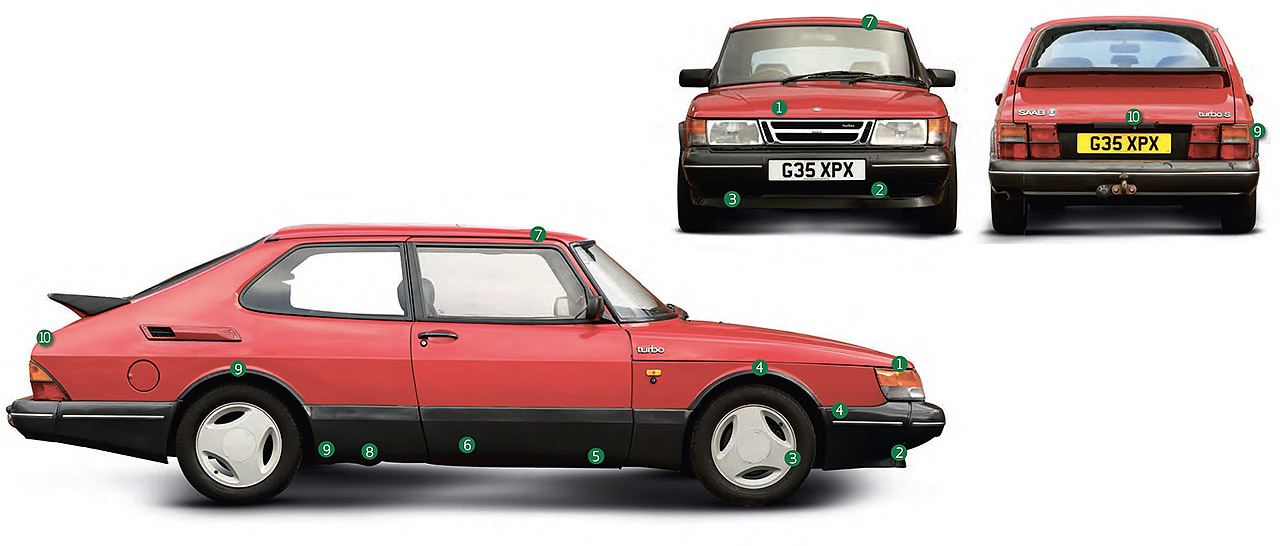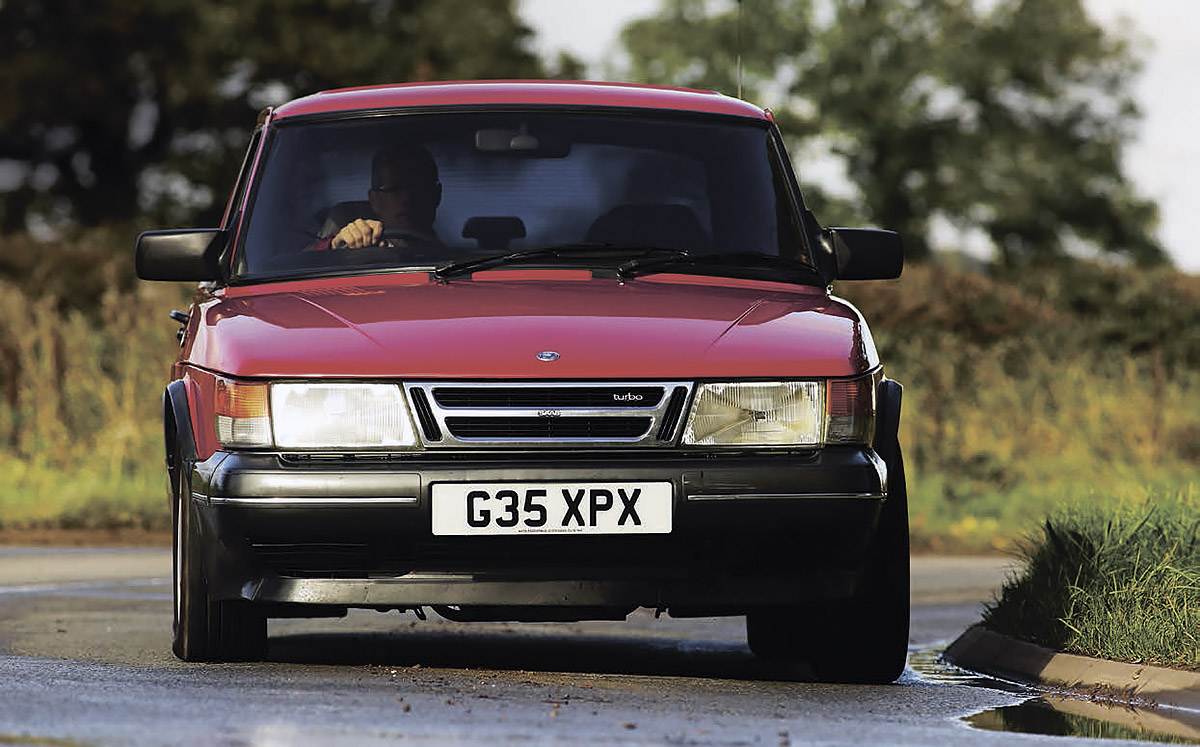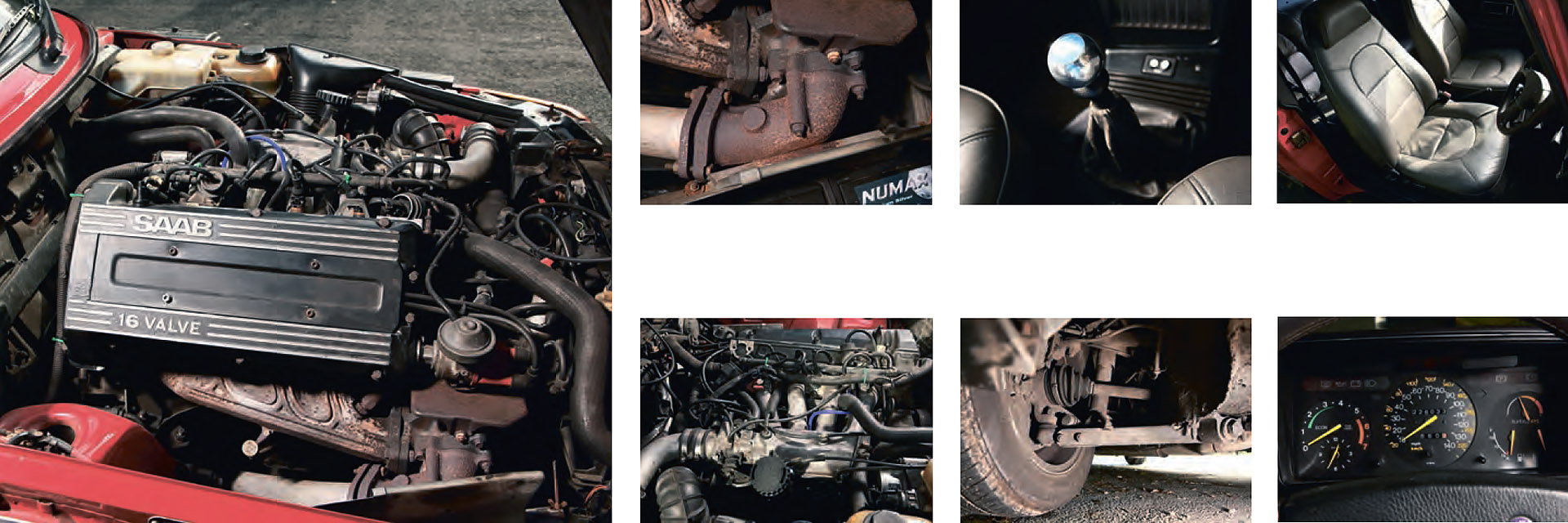
Saab 900 Turbo Buyer’s Guide. Buyer’s guide to the (almost) unbreakable Saab 900 Turbo. ‘The most intelligent car ever built’ now makes a great classic, as Malcolm McKay explains.
Saab made automotive headlines in the late 1970s with its 99 Turbo, extracting unimagined torque and power from the Triumph Dolomite-derived slant-four. Incredibly, the firm kept it reliable and long-lived, even with twin overhead camshafts and 185bhp. Where other early turbo vehicles were all about high revs and suffered huge lag, Saab engineered its cars more along the lines of its Scania lorries. Boost came in at lower revs for superb overtaking, without dramatically increasing fuel consumption. That’s provided you used the gearbox – punch below 2000rpm was still not great until the turbo spooled up. As Motor put it in 1977, ‘between 40 and 100mph (in top), the Saab accelerates faster than just about any four-seater saloon’.

Cabriolet, launched in 1985, features a clever powered top.

Early cars had signature Inca alloys; note side-impact bar.
But the 99 was already 10 years old: a replacement was vital, so Saab stretched the wheelbase, further improved the front suspension and crash protection, and launched the 900 in 1978. Testers raved over its quality and integrity, its performance and refinement: by 1983, Saab led the world in turbocharged cars, having sold 100,000.
The elegant Cabriolet was added to the range in 1985, with its rear spoiler around the lip of the fully retractable, double-insulated hood, which featured a unique opening glass rear screen.
With excellent build quality and engineering thoroughness, it shouldn’t be a scary classic to own or buy, but there are rusty and neglected examples out there and durability is very dependent on good maintenance and driving practice. A careless driver can wreck a gearbox in 30,000 miles (Motor broke its when road-testing the T16), whereas others last 300,000 miles. There are many variants, in body style and mechanical spec, so it’s worth searching for the one that suits you best: most sought after is the last of the line Ruby. Full-pressure turbos have a boost gauge above the fuel gauge; low-pressure turbos don’t.
Rot is the biggest issue: although the cars were built to withstand Scandinavian winters and last better than most, it is still the main killer. Check carefully, also for signs of accident damage (wrinkles in chassis legs, poor panel gaps) and for mods that may put excessive strain on other components. On Cabriolets, run the hood up and down a couple of times to ensure that all is well – the hydraulic- cum-mechanical system rarely gives trouble.

Rot spots
1 Bonnet
2 Front valance and radiator support beam
3 Crossmember under ’box; wishbone mountings
4 Inner and outer front wings, plus wheelarches
5 Sills and jacking points
6 Doors: bottoms and behind plastic trim
7 Sunroof
8 Rear suspension arms and mountings
9 Rear floorpan and inner/outer arches
10 Tailgate
What to look for
The engine’s idler shaft and drive gear were removed from late 1980, saving 12kg, and a smaller, lighter turbo was fitted. Oil-change intervals went up from 6000 miles to 10,000 on late versions, although many prefer to do it every 3-5000 miles; it blackens quickly due to the turbo’s high operating temperatures. It is wise, especially on non-intercooled cars, to let the engine tick over before shutting down.
Hydraulic tappets, on 16v models, may chatter on start-up from cold, but should soon quieten. Eight-valve tappets are shimmed, and fiddly to set up. If the engine rocks when revved, budget to replace the hydraulic engine mountings quickly before the gear selectors are damaged.
Cooling systems worked hard – battery acid could boil in hot climates due to turbo heat! – so look for head-gasket issues, as well as a corroded rad, plus leaks from it or the water pump. APC engine management on 16v is costly to repair; it monitors and controls induction pressure, allowing 0.85 bar boost on a 9:1 compression engine.
Tuning is popular but more than 200bhp will shorten the life of the whole drivetrain. Gearbox problems mean a costly engine-out repair; new parts are scarce but specialists have used stocks. Auto ’boxes are not cheap to rebuild, either. Brakes can seize (especially the handbrake, which works on front discs up to 1988 and is a common MoT fail) and corrode; check that they respond well. There was a wide range of suspension settings and alloys; original Turbo 16S had the firmest set-up, and 195/60 tyres (standard on three-door) are the widest that fit properly.
OWNER’S VIEW
Alwyne Bates
“I bought a four-door 20 years ago,” recalls Bates, “because we liked the styling. Since then we’ve had more than 40 and I recently bought a Full Pressure Turbo Cabriolet. I bought it unseen as an LPT, so was delighted to see the Turbo badge on the back that meant it was an FPT. It was one of the last built, with electric seats, aircon and full leather. The hood didn’t work but it was just low on hydraulic fluid, and there was a water leak that I’ve sorted. It’s done 177,000 miles, which doesn’t bother me, and was great value for £1500. I’m 65 now and hope to still be driving it in 20 years’ time. I wouldn’t buy anything else: they’re quiet, comfortable and easy to maintain. I’ve got everything that I need for them and know what to do if anything goes wrong.”
One to buy £3600
Year of manufacture 1991
Recorded mileage 34,093
Vendor TDC Car Care, St Albans, Herts, tel: 01727 811000; tdcsaab.com
For Cheap; rot-free; drives well.
Against Scuttle paint not great.
This T16S auto was supplied new to Hong Kong and had its speedo replaced at 95,050km when it reached the UK in 2003, so the actual mileage is about 93,000. There’s pretty much a full service history and recent bills show that it’s had new front swivels and CVJ boots. Its tyres have decent tread all round: newish Landsails on the front, plus a Pirelli P6000 and a budget Hi-Fly on the rear. The spacesaver spare looks slightly used. The bodywork is straight and the doors fit and shut well, although they have a few rust perforations on their inner lower faces that are almost hidden by the rubber seals and trim.
The bonnet and scuttle have been repainted: it’s a good match, but there are dust and sink marks; the scuttle was sprayed with the screen in because there are some tiny bubbles (but no corrosion). It seems solid underneath, too, with a fresh-looking back half of the exhaust. The interior is excellent, the driver’s-seat hide lightly creased, plus tidy carpets and side trims. All of the electric windows work, as does the hood. It starts easily with no smoke or rattles, and drives smoothly. Coolant temperature sits just above ‘L’ and if you floor it you feel the turbo come in as the boost gauge flicks to the top of the yellow band. There’s no pinking, suggesting that the APC works fine. The auto ’box changes up smoothly and kicks down on demand, plus the brakes are smooth. The MoT runs until July.

Distinctive lines are clearly an evolution of the 99 Combi Coupé; practical, too, with loads of luggage space if you fold the seats.
Our verdict
Stunning value because it has survived in good numbers, the Saab 900 Turbo is at a cusp. Cheap cars are still being driven into the ground (and make a costly classic buy, due to the work involved in correcting that neglect), while properly maintained examples are beginning to be appreciated and rise in value. So it’s time to find a good one and look after it!
FOR +
• Unmistakable Saab style
• Intelligent, highly competent engineering
• Hugely durable if well looked-after
• Practical, usable year-round classic
AGAINST –
• Gearbox can be a weakness
• Handbrake suspect on pre-1988 models
• Everything wears out eventually, so beware
cars with huge mileages
Paint generally smart; hood looks to have been re-covered Cabin excellent overall, bar a few small cracks in dash top No obvious leaks; cleanish oil to ‘Max’; clear pink coolant.
TIMELINE
1978 5dr 900 launched: 5dr Turbo has 180/65s on turbine alloys; 3dr has 195/60 P6s on ‘Incas’
1980 New seats with adjustable headrests Aug H-series engine, 5sp gearbox, smaller turbo
1981 4dr saloon added; later 2dr – more rear headroom and pocket-sprung rear seat
1982 All Turbos have turbine alloys
1984 Sep Turbo 16S launched: twin cams, 16 valves, intercooler, APC, 175bhp, 134mph
1986 StandardTurbo gets intercooler, up to 155bhp: Airflow bodykit, large rear spoiler, wheelarch flares; convertible added, 10,000+ built
1987 Slant-nose front-end restyle, 2in shorter
1988 Turbo watercooled; 2dr T16: boot lip spoiler, 3-spokes; Carlsson 3dr launched, 185bhp, black, white or red, special bodykit, 600 built
1989 Turbo Anniversary: black, whaletail spoiler
1990 2dr 900 T16 and light-pressure 8v Turbo replaced by 900S 16v with light-pressure turbo
1991 T16 Aero introduced with 175bhp; light-pressure Aero added later
1993 Mar Final edition Ruby: aircon, special wheels/seats, no bodykit. Production ends
FACTFILE
Sold/number built 1978-1993/908,810 (all 900s)
Construction steel monocoque
Engine iron-block, alloy-head sohc (or dohc 16-valve) 1985cc ‘four’, Bosch electronic fuelinjection with Garrett turbo (intercooled on T16);
145bhp @ 5000rpm-185bhp @ 5500rpm;
173lb ft @ 3000rpm-201lb ft @ 2800rpm
Transmission 4/5-sp man (or 3-sp auto), FWD
Suspension: front double wishbones rear dead axle, longitudinal links, Panhard rod; coil springs, telescopics f/r; anti-roll bar f/r on T16S only
Steering power-assisted rack & pinion, 3.4 l-l
Brakes 11in front discs (ventilated from 1988), 10 1/4 in rear discs, with servo; ABS from 1989
Length 15ft 41/2in(4687mm)
Width 5ft 61/2in (1690mm)
Height 4ft 81/4in (1420mm)
Wheelbase 8ft 3in (2517mm)
Weight 2960-3000lb (1342-1364kg)
0-60mph 9.7-8.6 secs
Top speed 120-134mph
Price new £16,395-25,895 (1990)
Mpg 22-30
INSURANCE
£153.81, for a Londoner, 30, full no-claims/clean licence on an ’86 T16S as a garaged 2nd car, value £4500, 5000 ltd miles. Lancaster: 01480 484848.
THE ALTERNATIVES
AUDI 90 20V
Sharing many parts with Coupé quattro made this an exciting car, with a galvanised shell, 20-valve twin-cam ‘five’ producing 168bhp and 2/4WD. A cherished one could be a bargain. Sold/no built 1989-’91/184,907 (all) Mpg 20-32 0-60mph 8.7 secs Top speed 140mph Price new £19,014-21,381 (’90) Now £1-4000.
BMW 323i/325i
The sporty E30 packed a 141/169bhp ‘six’, with 5-speed manual or 4-speed auto in 2/4- door saloon, convertible or 5dr touring bodies; there was even a 4×4 version. Fun and good value. Sold/no built ’82-’93/2,339,520 (all) Mpg 22-35 0-60mph 10.3 secs Top speed 129mph Price new £17,975-22,235 (’90) Now £3-11,000.
The knowledge
WHAT TO PAY
Show FPT hatch/convertible £5000/10,000
Average FPT (LPT) £2250/3500 (£1.5/2.5k)
Restoration £300/1200
2/4dr saloon c20% cheaper than 3/5dr hatch
PARTS PRICES
Front wing £210
Headlamp rechrome (exch) £295
Engine top end overhaul £500-1000
T16 LPT chargecooler £999 (s/h from £30)
Gearbox minor rebuild £800-1000
Fuel pump £110
Brake master cylinder (non-ABS) £148
Convertible hood, fitted £1100
CLUB
Saab Owners’ Club
01954 232810; www.saabclub.co.uk
BOOKS
Saab 99 and 900 Complete Story,
Saab Cars Complete Story both Lance Cole,
Crowood Saab Turbo Graham Robson, Osprey
SPECIALISTS
Abbott 01255 870636 A&D 01935 420604
Classic 900 01482 222622 DCN (London)
07860 709614 Hagstrom 01953 602754
Malbrad 01484 544556 Motorvation 01892
825208 Neo Bros 01992 719280 Saab Parts
01234 756800 Saabtec 01457 867878
Two Stroke to Turbo 01763 246699

Cabin comfortable, just check that all of the gadgets work. Saab handles well, with strong grip and limited roll, but offers a decent ride on standard set-up; they’re all quick, too. If well maintained, the engine can exceed 400,000 miles without a major overhaul. Look for oil leaks from crank front seal/timing cover and rocker cover, also waterpump leaks. The timing chain should be replaced at about 125,000 miles, in situ on 16v; it’s officially an engine-out job on an 8v, but apparently there are ways… Early seat covers pull apart from ribs and fade. Look for dropping headlining and dash cracks. Hide was a desirable option. Secondhand items can be found. Turbos can last 200,000 miles: blue exhaust smoke when revved, or rattling, reveals one on the way out. Wastegate can stick shut, overboosting engine. Gearboxes can top 300k miles if used with respect, but can fail much sooner: check for jumping out of gear (notably reverse), rattles and bearing noise. Bosch injection is reliable. Saab’s novel Automatic Performance Control (APC) electronic knock/boost monitor can fail, causing pinking or poor performance. Ensure that driveshaft boots are intact and listen for clicking CV joints; look at bushes, for power steering leaks and corrosion around suspension mounts. Circuit boards/ancillary controls fail. Check all the electrical kit, esp on T16: sunroof, mirrors, windows, lamp wash/ wipe, locking, heated front seats etc.





